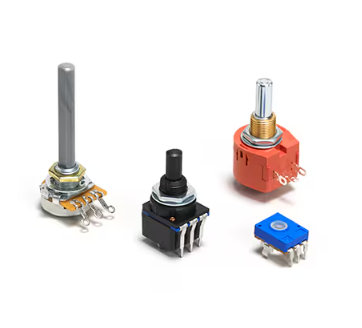Variable resistors are crucial components in electrical and electronic devices, allowing for the adjustment of their resistance values as needed. These resistors achieve adjustment by sliding a contact (wiper) over a resistive element. When a variable resistor utilizes all three terminals, it functions as a potentiometer, serving as a voltage divider. If only two terminals are used, it acts as a rheostat, providing variable resistance.

How Variable Resistors Work
Variable resistors, including both potentiometers and rheostats, are essential in applications where frequent manual adjustment of resistance is required, such as in volume, tone, focus, and brightness controls. Potentiometers, which have three terminals, are commonly used as voltage dividers and offer a wide range of resistance values but usually handle lower currents. Rheostats, on the other hand, typically have two terminals, handle higher currents, and have a more limited range of resistance values. Digital potentiometers are electronically controlled versions, allowing resistance adjustment without mechanical movement.
Types of Variable Resistors
Variable resistors come in various forms to suit different applications. The primary types are potentiometers, rheostats, and digital resistors, each with unique characteristics and uses.
- Potentiometers: These function as resistive dividers and are widely used to generate voltage signals based on the wiper's position. They are commonly found in applications like amplifier gain control, distance measurement, and circuit tuning. Trimmer potentiometers, or trimpots, are small adjustable versions used for fine-tuning on circuit boards.
- Rheostats: Used as variable resistances, rheostats typically have two terminals: one at the end of the resistive element and the other at the wiper. Historically used for power control, they are now mainly used for circuit tuning and calibration, with modern power control achieved through more efficient electronics.
- Digital Resistors: These adjust resistance electronically via digital signals rather than mechanical movement. They change resistance in discrete steps and are often controlled by digital protocols like I2C or simple up/down signals, making them ideal for applications requiring precise and programmable resistance adjustments.
- Rotary Variable Resistors: These feature a knob that can be turned to change the resistance. They are commonly used for manual adjustments in settings such as audio volume and lighting brightness.
- Slide Variable Resistors: These have a slider that moves along a resistive track to alter the resistance. They are often used in applications where linear adjustment is preferred, such as in audio mixing boards.
Features of Variable Resistors
- Precise Current Control: Ideal for applications that require fine-tuning of current flow.
- Two or Three Terminals: Can have two terminals (rheostat) or three terminals (variable resistor).
- High-Current Handling: Suitable for high-current applications, providing robust current control.
- Durability: Built to last and withstand extensive use.
- Various Types: Includes rotary and slide types, each suitable for different applications.
- Limited Resistance Options: Generally offers fewer resistance values compared to potentiometers.
- Calibration and Tuning: Often used for circuit calibration and tuning, ensuring optimal performance.
Applications of Variable Resistors
- Current Regulation: Used to control the amount of current flowing through a circuit. By adjusting the resistance, they allow for precise current control, crucial in maintaining optimal performance and safety in electronic circuits.
- Motor Speed Control: In motor drives and fan controllers, variable resistors regulate motor speed by adjusting the current supplied to the motor. This enables users to control the operational speed of motors and fans according to their needs.
- Light Dimming: Used in dimmer switches to adjust light intensity. They change the resistance in the circuit to control the current flow through lighting systems, allowing for smooth dimming of lights.
- Tuning Circuits: Applied in radio and communication equipment to fine-tune circuit parameters. By adjusting the resistance, they help optimize performance and frequency response in communication and radio systems.
- Load Testing: Utilized in electronic testing equipment to simulate different load conditions. They allow for testing the performance and stability of circuits under various load scenarios by adjusting the resistance and observing circuit behavior.
Advantages and Disadvantages of Variable Resistors
Advantages:
- Precision in Current Control: Offer excellent precision in controlling current, making them ideal for tuning and calibration.
- High-Current Suitability: Designed to handle higher current levels, which expands their applicability in power control circuits.
- Durability and Longevity: Built to be robust and long-lasting, variable resistors can withstand rigorous usage over time.
Disadvantages:
- Complexity in Voltage Control: May not be as intuitive or user-friendly as potentiometers when used for voltage control purposes.
- Limited Resistance Values: Offer fewer options in resistance values compared to potentiometers, which can limit their flexibility in certain applications.
Choosing Between Potentiometer and Variable Resistor
When choosing between a potentiometer and a variable resistor, the key difference lies in their functionality and application. Potentiometers, with their three-terminal design, are ideal for applications requiring precise voltage control and fine adjustments, such as in audio volume controls and calibration circuits. They offer accurate voltage or signal adjustments and are typically used in low-current scenarios.
Variable resistors, including rheostats and digital resistors, are more suited for applications where adjusting resistance and handling higher currents are necessary. They come in two or three terminals and are commonly used in motor speed controls, light dimmers, and load testing. While they provide broader resistance adjustments, they may not offer the same level of precision as potentiometers, making them better for general resistance control rather than precise voltage regulation.
Conclusion
Selecting between a potentiometer and a variable resistor depends on your application's needs. Use potentiometers for precise voltage adjustments and variable resistors for broader resistance control and higher current applications. Choosing the right component ensures optimal performance and functionality in your electronic projects.
 erinee
erinee
Discussions
Become a Hackaday.io Member
Create an account to leave a comment. Already have an account? Log In.